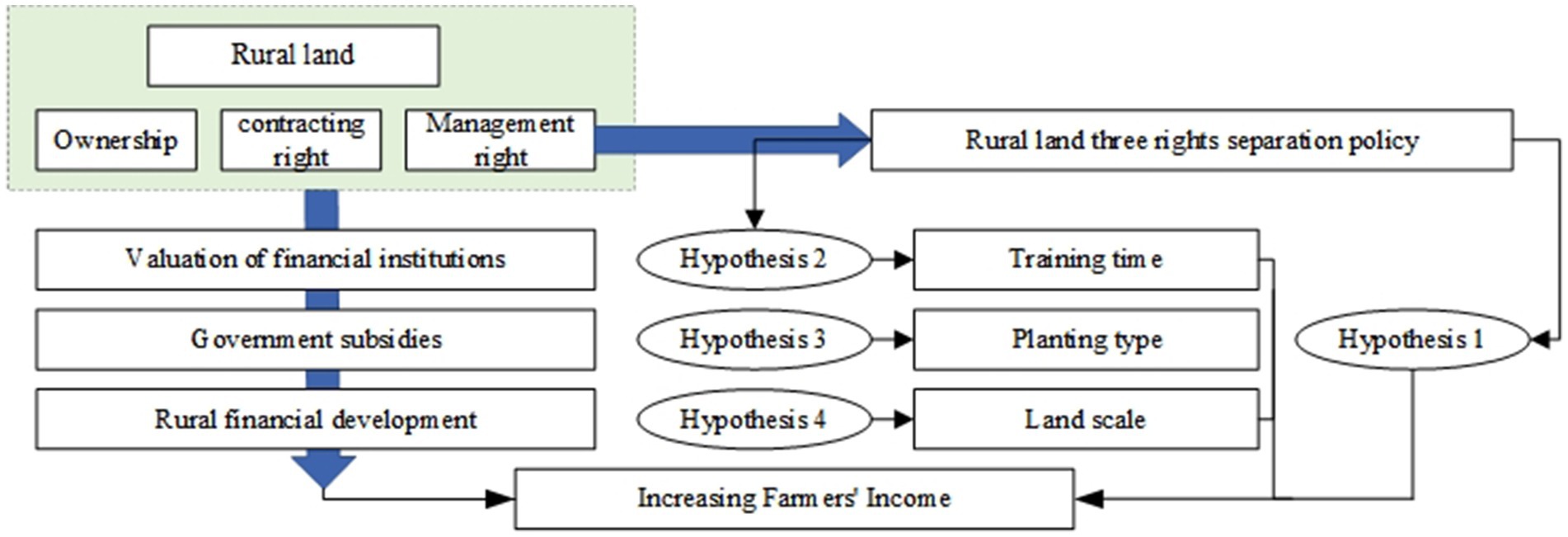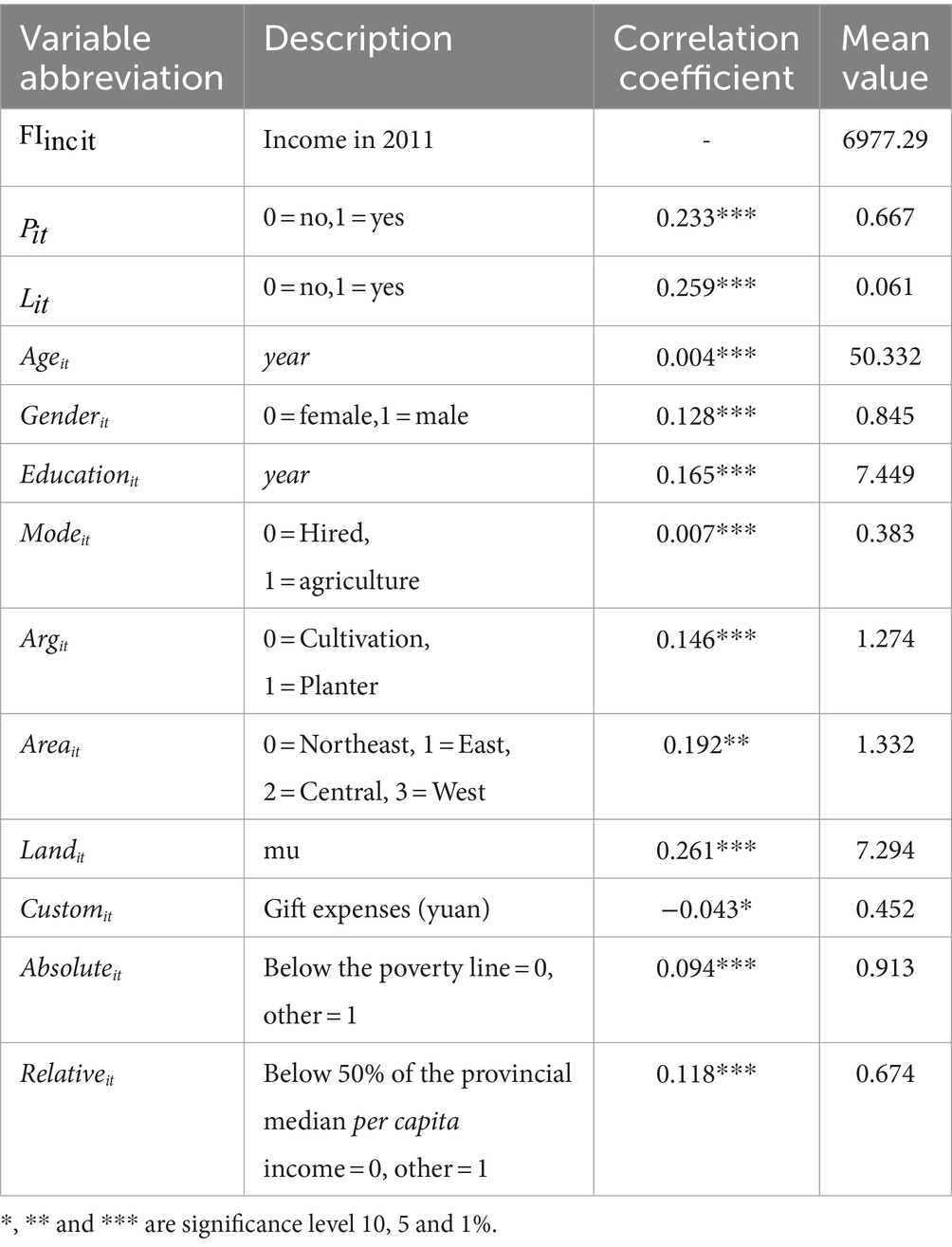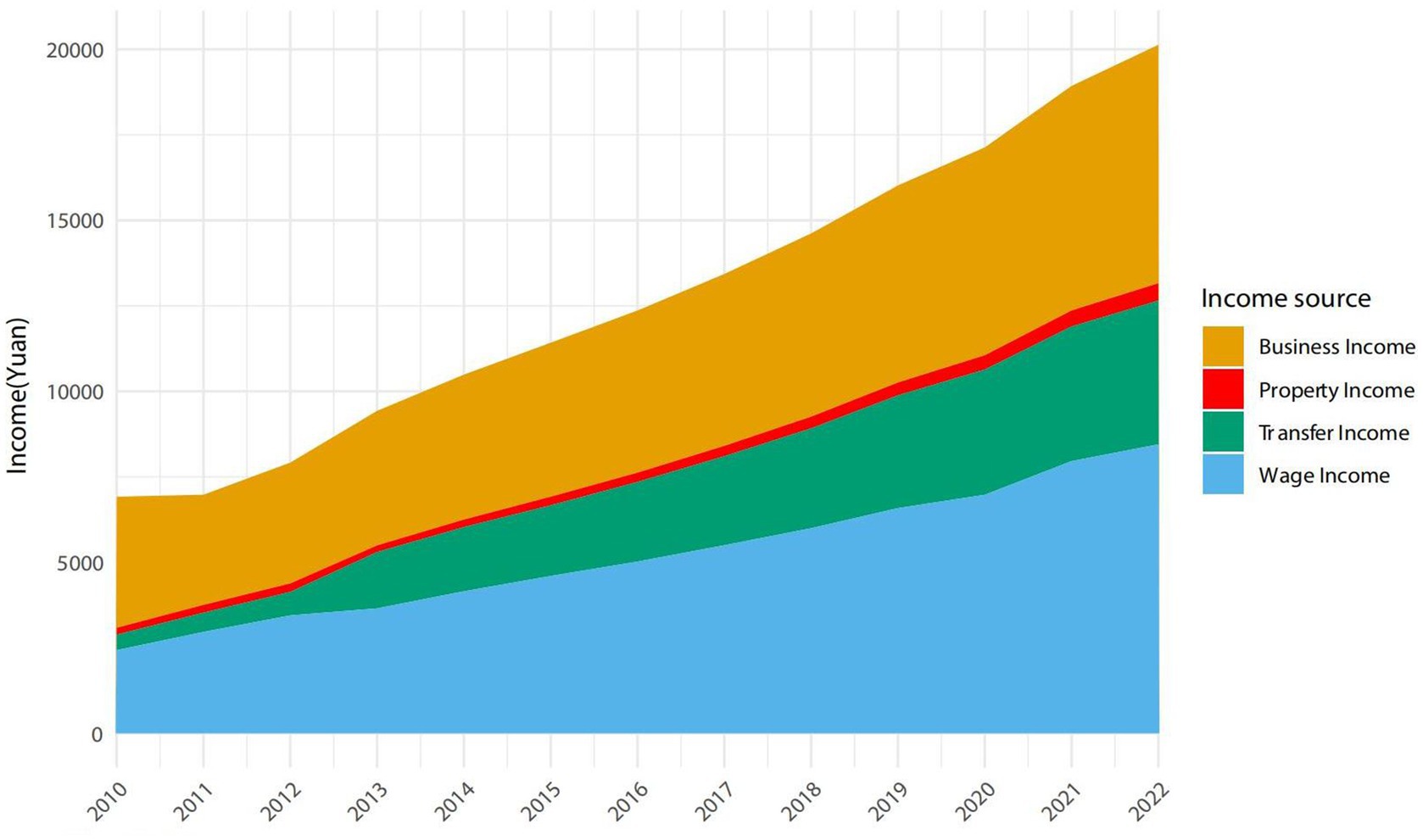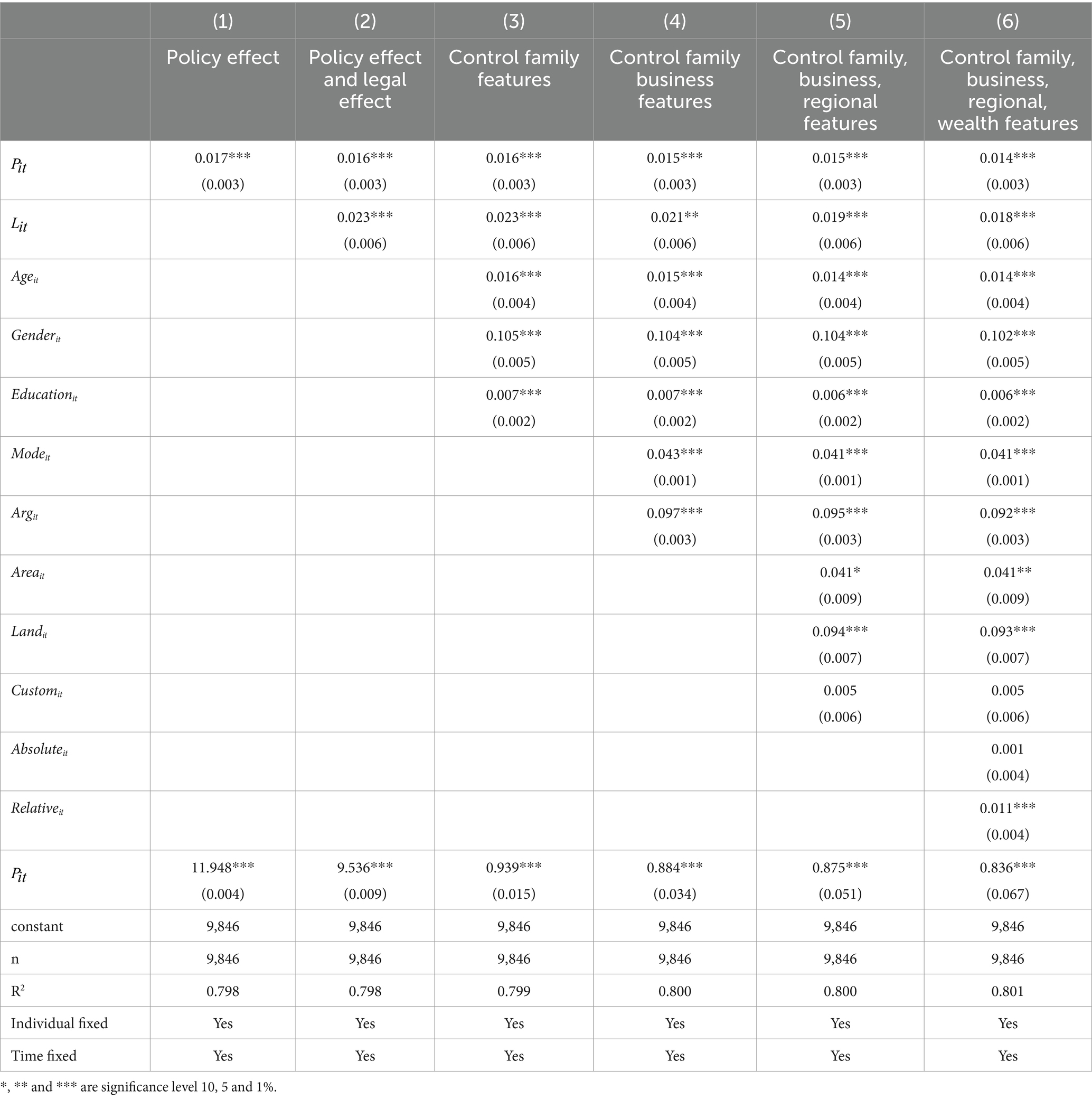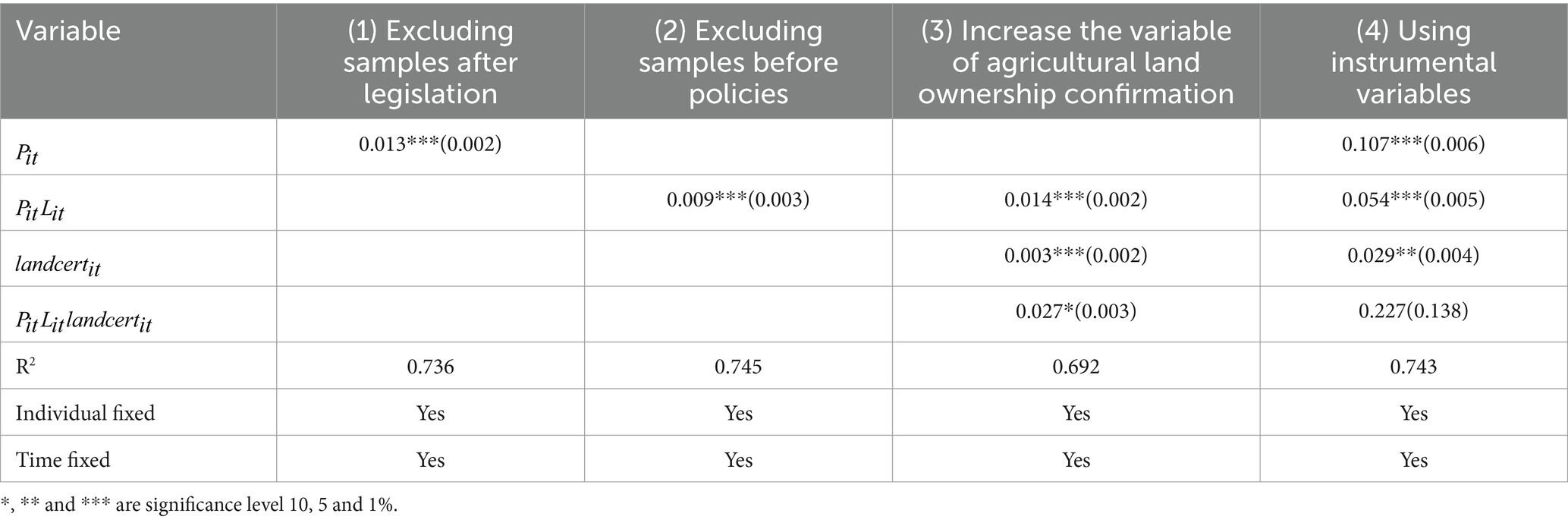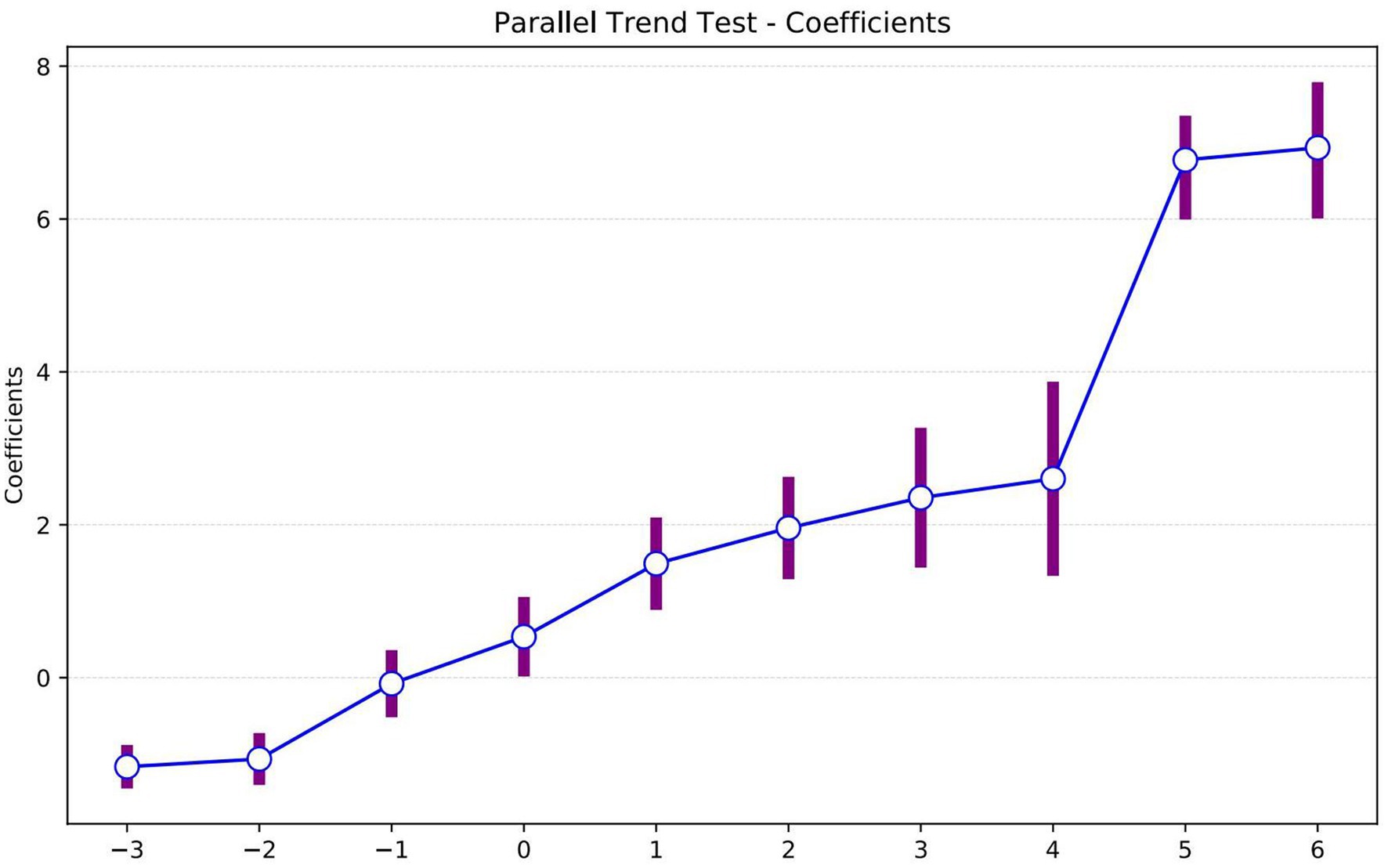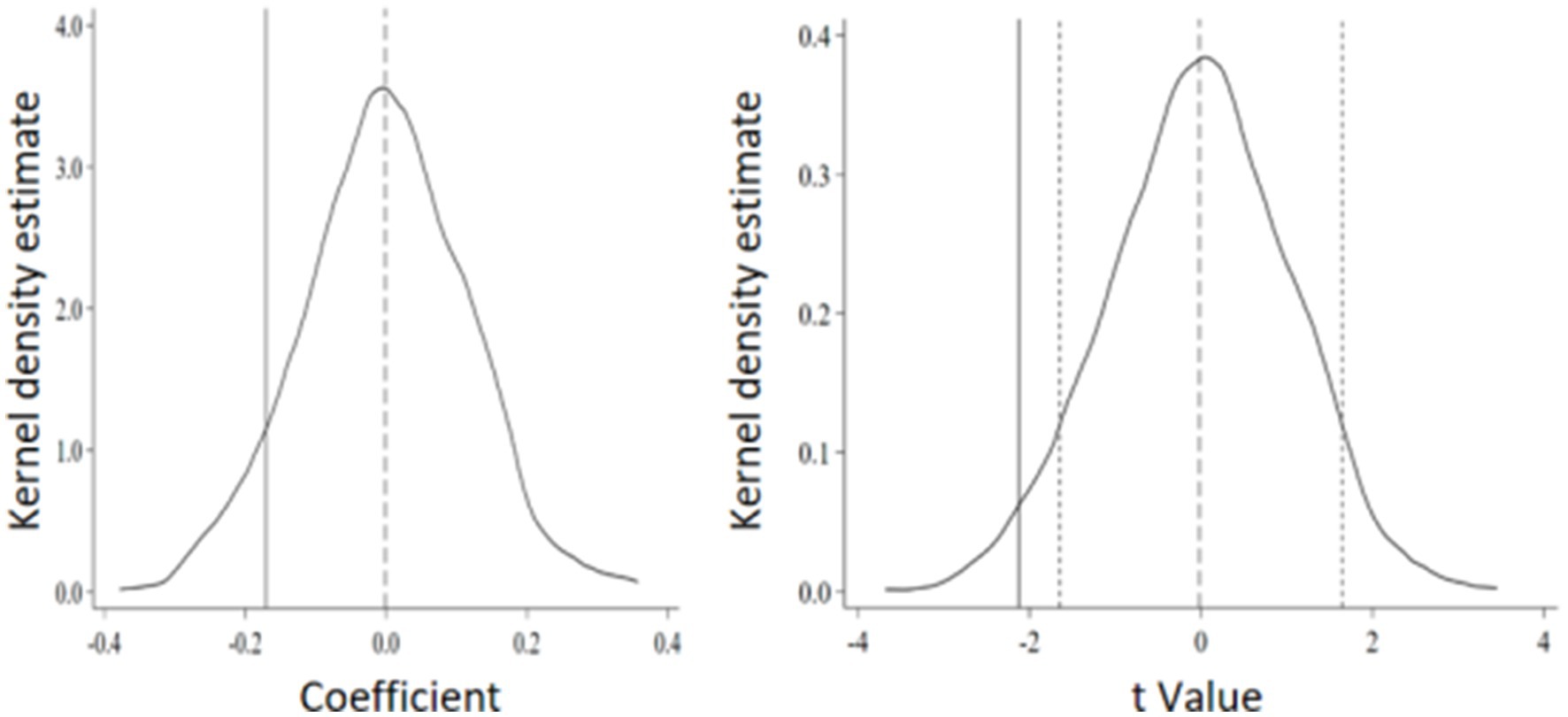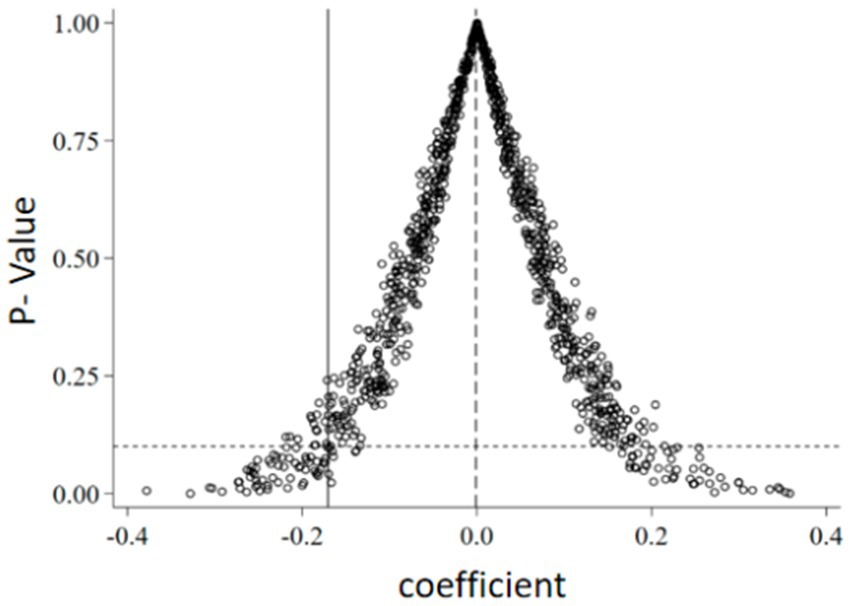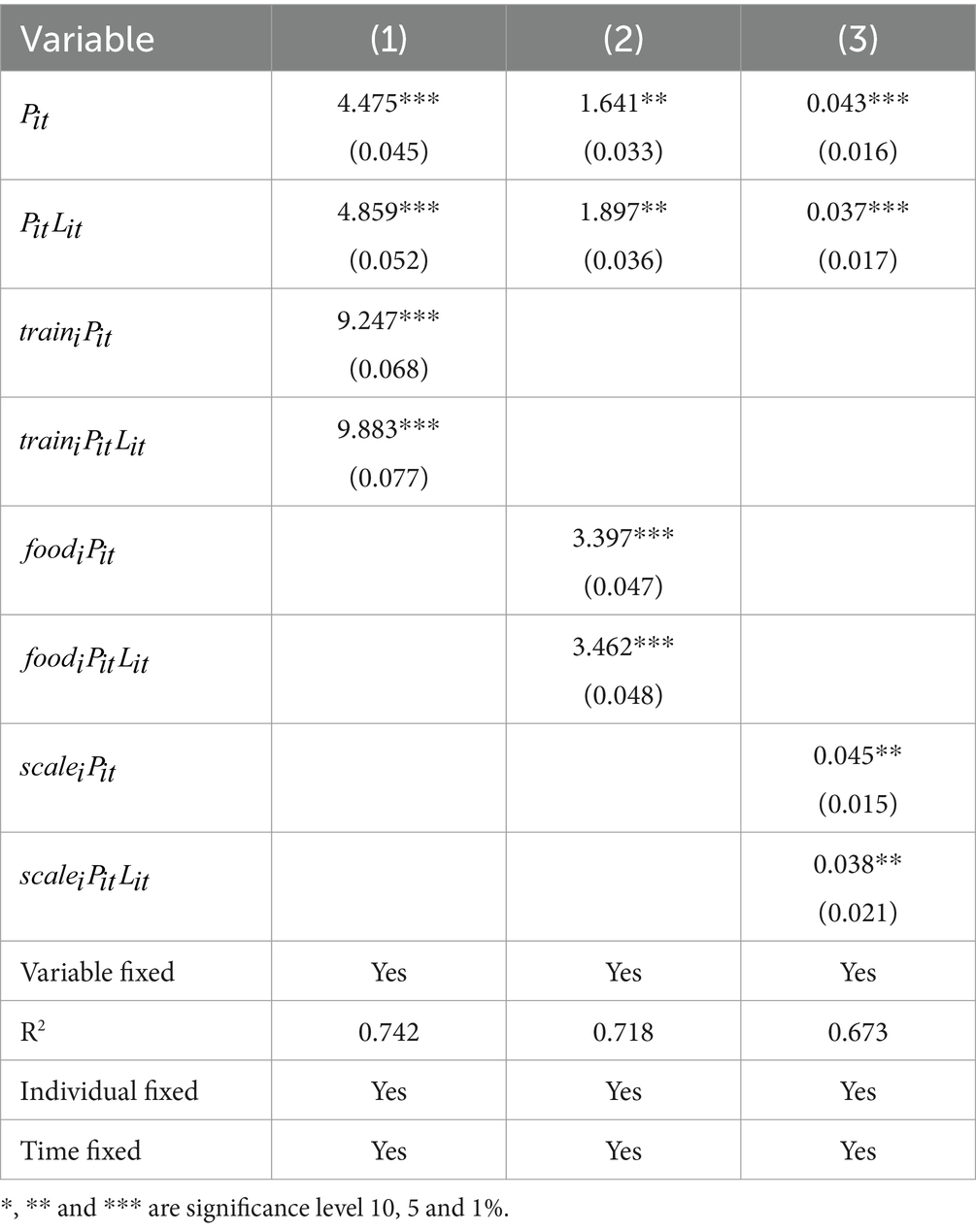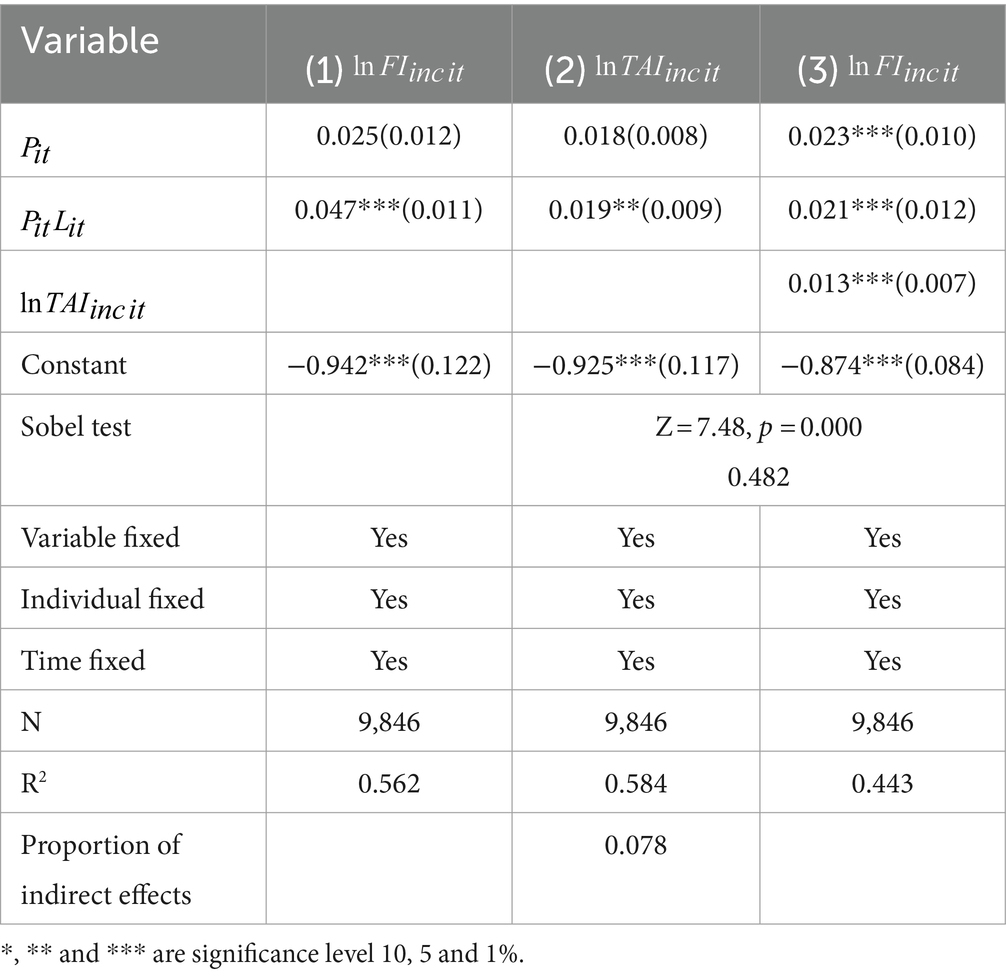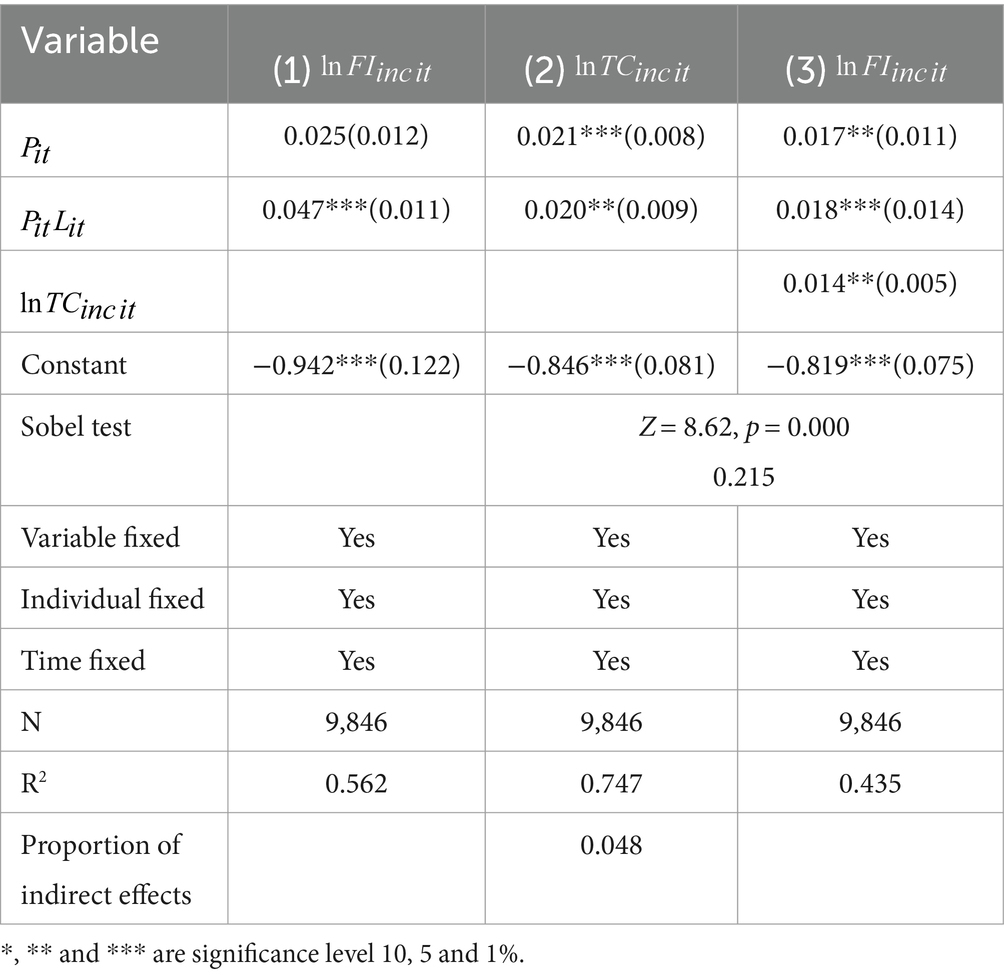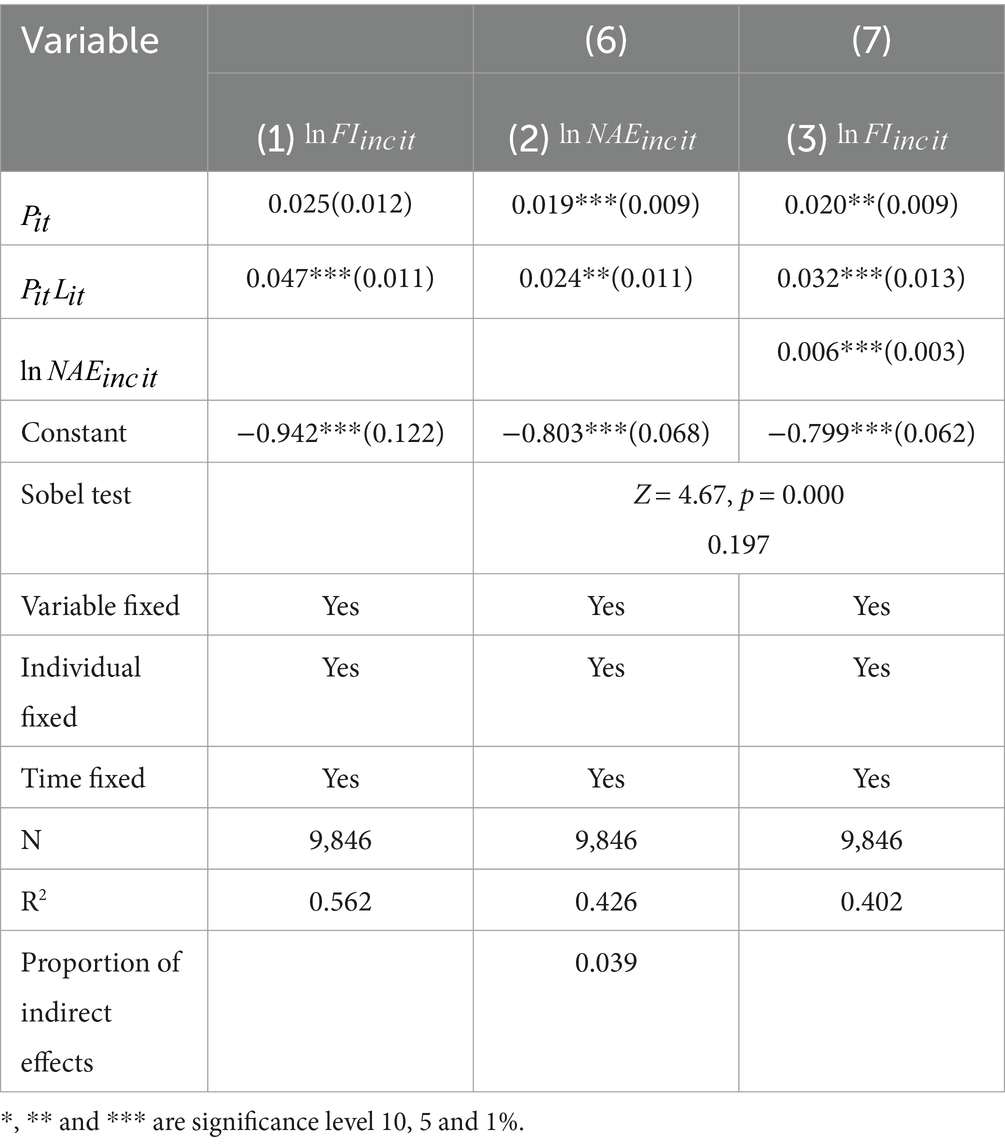- 1Business School, Lingnan Normal University, Zhanjiang, China
- 2Guangdong Coastal Economic Belt Development Research Center, Lingnan Normal University, Zhanjiang, China
- 3School of Economics and Finance, South China University of Technology, Guangzhou, China
- 4College of Software, Jilin University, Changchun, China
Introduction: As is well known, the policy of separating three rights is another important milestone in China’s land system reform. This policy has been in effect for 10 years and is of great significance to the livelihoods of rural families. In the implementation of policies, some farmers have obtained more land management rights, but some farmers have temporarily lost their land management rights. Existing research has shown that there is no consensus on the effect rural land three rights separation on increasing farmers’ income, especially in terms of heterogeneity research, which is more scattered.
Methods: We will use the latest national fixed observation point data from the Ministry of Agriculture and Rural Affairs from 2011 to 2020, as well as data from Peking University Treasure Database, West Lake Law Library Database, China Statistical Yearbook, and China Rural Statistical Yearbook. This paper matched the unbalanced panel data of 9,846 rural household samples from 30 provinces except Hong Kong, Macao, Taiwan and Xizang, and conducted an empirical study using the multi time point DID method.
Result: The overall result shows that the policy of three rights separation of rural land can improve the income of farmers, and the impact is more obvious after the promulgation of relevant laws. From the perspective of farmers’ heterogeneity, farmers with more training, food crop planting farmers, and farmers with relatively large land scales are more significantly affected by the policy’s income increase effect.
Discussion: Scholars have yet to find a good explanation for how the rural land three rights separation affects farmers’ income. In this article, it appears that the three rights separation policy has promoted the increase of farmers’ income through intermediary mechanisms such as investment level, credit level, and non-agricultural employment level.
1 Introduction
The report of the 20th National Congress of the Communist Party of China proposes to comprehensively promote rural revitalization and accelerate the realization of an agricultural power. Promoting rural revitalization in an all-round way is an important task for building an agricultural power in the new era. We should adhere to increasing farmers’ income as the central task and make every effort to broaden the channels for farmers to increase their income and become rich. Income always depends on means of production, and farmers are more dependent on land resources than urban residents. For thousands of years, land has carried multiple functions such as the survival, management, and old-age security of farmers, and is therefore regarded as an important support for farmers to increase their income. China’s reform originated in rural areas, with rural reform starting from land. The rural land property rights policy of separating rural land ownership, contracting rights, and management rights established in 2014 aims to continuously promote farmers’ income through property rights reform.
There are three main types of research related to the topic of this article. The first is the study of the land property rights system and the land three rights separation. Research on land property rights systems in foreign countries has been relatively early, focusing on the relationship between transaction costs (Galiani and Schargrodsky, 2010) and agricultural land transfer rates (Holden et al., 2011). Security and stability of land property rights, reducing land disputes caused by unclear boundaries (Deininger et al., 2011). The study of land property rights system in China originated after the founding of the People’s Republic of China, especially with the emergence of the household contract responsibility system, and more and more related research has been conducted (Bu and Liao, 2022). Until 2014, a large number of studies on the rural land three rights separation began to emerge, believing that property rights confirmation is beneficial for increasing the value of property rights and facilitating the identification of legitimate rights and interests by all parties involved in transactions, which helps to improve (Fang et al., 2022; Shi et al., 2023).
The second is the study of the impact of land property rights system on farmers’ income. This type of research has a large scope, a large number of domestic and foreign research achievements, and a more solid foundation. The stability of land rights can reduce investment risks and promote the increase of long-term investment returns in agriculture (Besley, 1995; Huang et al., 2017; Li et al., 2019). Improving the stability of land property rights can reduce the corresponding protection costs, enhance the uniqueness of land, and reduce the corresponding protection costs through the exclusivity of land use (Azzam et al., 2021). Unstable land property rights are like stable taxes that are levied at any time. Uncertainty can affect farmers’ production and operation expectations and frequently trigger land disputes. The rural land three rights separation in China is a continuation of its land system reform, and the separation of three circles has also had a certain impact on the income of farmers (Aldieri et al., 2021). Applying the theoretical model of land leasing market and introducing farmers’ variables, a study was conducted in some provinces of China. The separation of land rights means that agricultural land rights can be mortgaged, which can improve agricultural production performance (Deiningerk and Jin, 2004). Zhang et al. (2021) found that the separation of land rights and rural land mortgage promoted the possibility of farmers living abroad. The length of time spent living outside the country is an important influencing factor for farmers’ income level (Visser et al., 2020). Families’ risk financial investment and participation in the risk financial market have both increased with the length of time spent living outside the country (Matita et al., 2022). The impact of mortgage of management rights on farmers’ income in land system reform is uncertain (Kondolf et al., 2022). Some scholars believe that mortgage of agricultural land management rights is not conducive to income distribution (Luo et al., 2020; Peng et al., 2022). Radel et al. (2018) through reviewing the history of land evolution in Europe and the United States, found that mortgage of agricultural land can induce the concentration of land resources to a few farmers, which is more conducive to the investment of pesticides, fertilizers, and mechanized means, increasing the income of a small number of farmers, and harming the interests of the vast majority of farmers. Some scholars hold the opposite view, believing that the mortgage of agricultural land management rights promotes fair income distribution (Abdo, 2013; Myint et al., 2021). Tri et al. (2019) established a quantile regression model to analyze the income distribution effect of rural land transfer, and found that only the income increase effect of rural land transfer was significant, and it was more significant for farmers in economically developed eastern provinces.
The third is the study of the impact of the separation of land rights on resource allocation. The rural land three rights separation can promote the transfer of land management rights and facilitate the transfer of agricultural population to non-agricultural areas (Li L. et al., 2023). The new agricultural production methods such as agricultural trusteeship under the separation of three rights in rural land can promote the optimal allocation of production factors such as farmers and farmland, and also promote the transfer of rural labor to non-agricultural fields (Zhao et al., 2021). The rural population in China is increasingly shifting to urban areas, but currently the rural population base is still relatively large, and small farmers are still the main form of rural population in China (Yang and Qian, 2021). Through the reform of the separation of three rights in rural land, the land management rights can be revitalized, promoting the flow of modern production factors to agriculture and rural areas, and driving the modernization of small farmers (Peng and Zhou, 2021). But some scholars express concerns about the rural land three rights separation. The policy of separating three rights promotes the transfer of agricultural labor to cities, while also leading to further flow of agricultural production factors to cities, increasing the severity of imbalance (Li J. et al., 2023). The policy of rural land three rights separation has not fully respected the wishes and rights of farmers in its implementation, which has damaged fairness and sustainability, resulting in a lack of effectiveness in resource allocation (Xie et al., 2021).
There are many studies on the impact of rural land system on farmers’ income in existing literature, and research on the impact of the separation of land rights on agricultural production efficiency, land scale management, and rural population urbanization has also formed a certain scale. However, there is relatively little research on the relationship between the rural land three rights separation policy and farmers’ income, and there is also controversy over its positive and negative effects, and the research conclusions are not yet clear. At present, there is a lack of research analyzing the impact of the rural land three rights separation policy on household income effects from the perspectives of family heterogeneity and intermediary mechanisms. This article uses data from 2011 to 2020 to analyze 30 provinces in China, which helps to explore the deep relationship between the rural land three rights separation policy and farmers’ income increase, clarify the mediating effect between these two variables, and provide ideas for accurately implementing policies to achieve common prosperity in agriculture and rural areas.
2 Research hypothesis
For a long time, Chinese farmers have been unable to obtain production funds by using land as an effective asset as collateral, which has seriously restricted their enthusiasm for production and management. In order to enable farmers to obtain more property rights and financial support, in 2014, China officially proposed a pilot policy of three rights separation, separating the management rights of land from the contractual management rights. Theoretically, farmers’ production and operation require financial resources and financial support, and mortgage loans for agricultural land management rights increase their likelihood of obtaining corresponding support. In particular, after the promulgation of The Rural Land Contract Law of the People’s Republic of China (hereinafter referred to as the “Rural Land Contract Law”) in 2019, it was endorsed in legal form. The policy has improved the allocation efficiency of land resources for rural households, allowing family labor to choose industries based on needs, with a strong family income effect. As the main economic person, farmers will coordinate mortgage loans in accordance with the optimal principle. Clear property rights will enable farmers to make rational decisions, reduce friction in the land mortgage process, and reduce the transaction cost of land mortgage. Farmers obtain dividends by mortgaging their land management rights to the collective and participating in the collective purchase of shares. This is also an important way for the three rights separation to increase farmers’ property income (Holden and Yohannes, 2002). When members of a collective economic organization have the right to contract, quantifying the land contractual management right into shares accelerates the process of land ownership confirmation and ensures the property rights of farmers. Based on this, the following hypothesis are proposed.
The principles of industrial economy are also applicable in agricultural economy. As the actual scale of farmers’ land management continues to expand, the cost allocated to unit land or unit agricultural products will become lower and lower. Even if the technical conditions remain unchanged, the internal economies of scale effects will become particularly evident, leading to an increase in agricultural profits and an increase in farmers’ income. Farmers obtain dividends by mortgaging their land management rights to the collective and participating in collective investment, which is also an important way for the three rights separation policy of land to increase their property income (Long and Tang, 2021). When members of collective economic organizations have the right to contract, quantifying the land contract management right into shares accelerates the process of land ownership confirmation and safeguards the property rights of farmers. Based on this, hypothesis 1 was proposed.
Hypothesis 1: The policy of rural land three rights separation can improve the income of farmers, and the impact is more obvious after the law is promulgated.
Based on the assumption of economic man, on the one hand, training have a positive impact on the policy of rural land three rights separation. Farmers who have received more training are more rational in calculating the costs and benefits of agricultural production and non-agricultural operations, especially in analyzing the potential risks and comparative benefits brought by rural land three rights separation. After fully weighing the risks and benefits, make a decision on whether to mortgage a loan based on one’s own situation, rather than blindly rejecting it. On the other hand, training and education have an indirect impact on the incentive for farmers to increase their income in the policy of three rights separation in rural land. Farmers with more training and education have a strong ability to engage in large-scale agricultural production and operation, and their liquidity asset allocation, production fund acquisition, and income and expenditure management level are high (Cui et al., 2021). Based on this, hypothesis 2 was proposed.
Hypothesis 2: Farmers with more training are more significantly affected by the income increase effect brought by the policy of rural land three rights separation.
Mortgage loans for agricultural land management rights can effectively stimulate the expansion of the planting scale of economic crop farmers, while achieving the effective transfer of surplus household labor and expanding the multi-channel income sources of farmers (Ege, 2017; Fu and Hu, 2022). The benefits of developing food crops are relatively low, and farmers who grow food crops are more numb and slow in implementing the policy of dividing agricultural land ownership into three categories compared to those who grow economic crops. Economic crop planting farmers have achieved a transformation from traditional small-scale farmers to professional farmers through mortgage loans. The agricultural production mode is efficient and intensive, achieving connotative income growth for farmers, improving the level of agricultural production and operation, and optimizing the total factor productivity of agriculture. Economic crop farmers have higher resource allocation efficiency, and production factors such as land, capital, technology, and labor can complement each other, resulting in better income growth effects. Based on this, hypothesis 3 was proposed.
Hypothesis 3: Compared with food crop farmers, the policy of rural land three rights separation has a more significant impact on economic crop farmers’ income.
Small scale farmers tend to flow out of the land, while large scale farmers tend to flow into the land in order to achieve scale management (Ye et al., 2023). Therefore, the absolute scale of land will have an impact on the mortgage of agricultural land management rights. Due to the immovable nature of land, land mortgage and transfer are unlikely to occur in distant areas. Therefore, the relative size of land (the relative ranking of farmers’ land size in their respective villages, as discussed later) will also have an impact on the mortgage of agricultural land management rights. Farmers with relatively large land scale are more inclined to use mortgage loans for agricultural land management rights to obtain funds, further expand production and operation scale, pay attention to relevant policy changes, and improve the level of scale income. Based on this, hypothesis 4 was proposed.
Hypothesis 4: The policy of rural land three rights separation has a more significant effect on the income of farmers with relatively large land scales.
The theoretical causal relationship between the rural land three rights separation and the assumed conditions and the increase in farmers’ income can be seen in Figure 1.
3 Data and methods
3.1 Data source and processing
The data source includes the latest national rural fixed observation point data from the Ministry of Agriculture and Rural Affairs from 2011 to 2020, covering 23,000 farmers in 360 administrative villages in China. Due to special reasons, no statistical surveys were conducted in 1992 and 1994, and 33 statistical surveys had been completed by 2020. Data sources also include the Peking University Magic Treasure Database and the West Lake Law Library database, which are used to collect statistics on local regulations related to the separation of land rights, land tenure, and land tenure. Query the data from the “China Statistical Yearbook” and “China Rural Statistical Yearbook” to supplement it to meet the needs of the relationship between the separation of land rights, land tenure, and rural household income increase. Due to the lack of data in Xizang, this article finally matched the unbalanced panel data of 9,846 rural household samples from 30 provinces except Hong Kong, Macao, Taiwan, and Xizang. We acknowledge that excluding Hong Kong, Macao, Taiwan, and Xizang may raise concerns about data representativeness, which is an important limitation. Given that rural land in China is collectively owned, whereas in Hong Kong, Macao, and Taiwan, it is privately owned, it is challenging to include them in our study. In addition, since Xizang is located in a plateau area with a large area and a small population, the policy of rural land three rights separation has not been implemented. Although our research did not cover these regions, the unique characteristics of these individual areas do not hinder our in-depth analysis and exploration of mainstream rural family issues in China.
In terms of data processing: (1) Land area is an important variable in the rural land three rights separation, and the per capita land resource endowment varies greatly among provinces. Farmers with an operating area of 30 mu or more are considered as large-scale farmers; (2) Winsorize the variables at a level of 1% to reduce the adverse effects of extreme values; (3) The data processing software uses Stata16, and the core explanatory variables come from the Peking University Magic Treasure Database and the West Lake Law Library database. The control variable data comes from the national rural fixed observation point data and statistical yearbook.
3.2 Methods
Differences-in-Differences method (DID) is an effective economic policy evaluation method that estimates policy effects by comparing the differences between the treatment group (affected group) and the control group (unaffected group) before and after policy implementation. In the context of the policy of separating the three rights of rural land, the DID method can help us accurately identify the net effect of the policy on the growth of farmers’ income, thereby better understanding the effectiveness of the policy. Parallel trend testing is an important prerequisite assumption of the DID method, which requires the treatment group and the control group to have similar trends before policy implementation. If the parallel trend assumption is met, we can be more confident that the differences after policy implementation are caused by the policy itself, rather than other external factors or differences in initial conditions. Therefore, the rationality of parallel trend testing lies in its ability to ensure that the policy effects we estimate are accurate and reliable. The implementation of the three rights separation policy is aimed at optimizing the allocation of rural land resources, improving land use efficiency, and promoting increased income for farmers. The target audience of this policy is the vast majority of farmers, who have similar economic characteristics and growth trends before the policy is implemented. In addition, policy implementation is usually carried out over a larger geographical range, which also helps to meet the parallel trend assumption, as a larger sample size can reduce bias caused by specific regional factors.
In practical situations, the rationality of meeting the parallel trend test can be demonstrated from the following aspects: first, the data before policy implementation supports the parallel trend hypothesis. By conducting statistical analysis on the income data of farmers before policy implementation, if it is found that the growth trends of the treatment group and the control group are similar without significant differences, then this can preliminarily support the parallel trend hypothesis. Secondly, the universality and indifference of the policy itself. The three rights separation policy is a universal policy implemented for the entire rural area, aimed at optimizing land resource allocation and improving land use efficiency, rather than targeting specific areas or groups of farmers. Therefore, the impact of policies on the treatment group and control group should be indistinguishable, which helps to satisfy the parallel trend hypothesis. In addition, the selection of control variables is also crucial to ensuring the validity of the parallel trend hypothesis. In the DID model, by introducing appropriate control variables, potential differences between the treatment group and the control group can be further reduced, thereby enhancing the validity of the parallel trend hypothesis.
3.2.1 Basic model design
The policy of rural land three rights separation was formally proposed by the central government in 2014 and was clarified in legal form through the Rural Land Contract Law in 2019. Before the central government proposed the policy of rural land three rights separation in 2014, provinces have not submitted any policy documents on agricultural land mortgage. During the period from 2014 to 2019, 21 provinces and cities have successively launched relevant policy documents. This article refers to Beck et al. (2010) time varying difference in difference method, and sets the model as follows:
Where, represents the logarithmic value of the household income of the i household in the t year (2011 is the base year).
indicates that after the implementation of the policy of rural land three rights separation in 2014, whether the location of farmer household i has issued relevant regulations is the core explanatory variable. When the regulations were issued, the value is 1, otherwise it is 0.
indicates that the location of the ith farmer household is clearly defined in legal form, and is included in the model together with the interaction item of , indicating the policy lag effect of the implementation of the Rural Land Contract Law after 2019.
represents a control variable composed of a series of control variables, including household characteristics, business characteristics, regional characteristics, and wealth characteristics of farmers. Among them, family features include Age(Ageit), Gender (Genderit), Education Level (Educationit). The business features include the Management Mode(Modeit) and the Farming Mode (Argit). Regional features include Area (Areait), Agricultural Land Area (Landit) and Customs (Customit). The wealth features include Absolute Poverty(Absoluteit) and Relative Poverty(Relativeit).
represents individual fixed effects, represents time fixed effects, and represents residual perturbation.
The correlation coefficient of policy pilot in Table 1 is 0.233, indicating a positive correlation effect. Other indicators have also passed the significance level test.
3.2.2 Robustness check model
To evaluate the pilot effect of the rural land three rights separation policy, it is necessary to test the parallel trend of farmers’ income in the dependent variable, and only when the parallel trend conditions are met can the implementation effect of the rural land three rights separation policy be analyzed. The parallel trend test can be verified using Formula (2).
The placebo test is a commonly used experimental design method, mainly used to distinguish between real processing effects and effects caused by measurement errors and other potential confounding factors. Considering that other policies or random impacts may lead to changes in the trend of the treatment group and control group after the implementation of the land separation policy, it is necessary to conduct placebo trials using a randomized treatment group and control group approach. In year t, if there are m municipalities that have introduced policies related to the separation of land rights, m municipalities will be randomly selected from all 30 provinces in that year as a new pilot for the separation of land rights, forming a new farmer treatment group and a control group, and calculating the municipalities that have completed the placebo test.
3.2.3 Heterogeneity and mediation effect inspection model
The situation of farmers varies, and the impact of the separation of land rights policy on the income growth of different farmers will exhibit heterogeneity. Design a model considering three factors: farmer training, planting type, and relative land scale.
In order to test whether training other than academic education for rural households will trigger the impact of the policy of the rural land three rights separation policy on their income, a model can be designed as Formula (3):
Different types of planting farmers adopt different planting techniques, face different market environments, and planting cycles, which may lead to different impacts of the land separation policy on farmers’ income. The design model is as Formula (4):
Based on Formula (1), add a dummy variable of the relative size of land ( ), and adjust the model as Formula (5):
The policy of three rights separation of land can promote farmers’ income, but its impact mechanism needs to be further explored. The intermediary effect model is established as follows:
In Formula (6) and Formula (7), represents intermediary variables, including investment level, credit level, and non agricultural employment level. The total agricultural investment of farmers is used to reflect the investment level ( ), the total credit amount of farmers is used to reflect the credit level ( ), and the non agricultural labor time of farmers is used to reflect the non agricultural employment level ( ). The other variables have the same meaning as in Formula (1).
4 Results
Figure 2 shows the per capita income level and composition of Chinese farmers from 2010 to 2022, and it can be observed that there has been a significant increase in income over the past 13 years. The per capita total income increased by 1.90 times from 6919.01 yuan in 2010 to 20132.8 yuan in 2022. Among them, wage income increased the most significantly, from 2431.05 yuan to 6018.15 yuan, an increase of 2.47 times. There has been some fluctuation in operating income, but the overall trend has increased from 3832.8 yuan to 6971.5 yuan, an increase of 0.82 times. There was a significant leap in transfer income in 2013, which may have been influenced by some policy adjustments or external capital injections. Afterwards, the transfer income also maintained a certain growth momentum. The red area in Figure 2 represents property income, mainly through the transfer of land rights. Although it does not account for a high proportion of the total income, a significant increase of 1.52 times can be seen. Property income is mainly due to the economic benefits obtained by farmers through holding and managing property, which may come from various channels, including land transfer and other benefits brought by land property rights. Land transfer, as a form of property income, may lead to an increase in other income.
4.1 Benchmark regression analysis of the impact of farmers’ income
Table 2 shows the benchmark regression results of the impact of the rural land three rights separation policy on farmers’ income. The number without parentheses corresponding to the variable represents the regression coefficient, reflecting the magnitude and positive or negative direction of the correlation. The numbers in parentheses indicate standard error. These two types of numbers have been explained in the text according to the opinions. The total household income of farmers is a dependent variable. After adding control variables, all models can control individual fixed effects and time fixed effects. The calculation results in Table 2 show that the introduction of policy effects in column (1) only resulted in a 1.7% increase in income for farmers, with an increase of approximately 979.85 yuan per household, which passed the 1% level test. However, from the perspective of the amount of income increase, it is far from the total annual income of 57638.37 yuan. Column (2) introduces policy effects and legal effects, achieving control of the interaction between the two effects. Due to the promulgation of the Rural Land Contract Law, farmers’ income increased by 2.3%, while the estimated parameter of policy effects decreased to 0.016, indicating that the policy bias effect has also been weakened. Columns (3) to (6) gradually control household characteristics, business characteristics, regional characteristics, and wealth characteristics of farmers based on each column. This indicates that the reliability of the estimated results is high. Since the introduction of the rural land three rights separation policy in 2014, especially the establishment and promulgation of the Rural Land Contract Law in 2019, it has brought a positive impact on increasing farmers’ income. Based on this, hypothesis 1 is verified.
Considering that the confirmation of agricultural land rights is an important condition for the rural land three rights separation, and there are still many areas that have not been fully confirmed after the rural land three rights separation policy, further control has been exercised over the confirmation of rights and its interaction with the core independent variable ( ; column 3 of Table 3). Due to the fixed observation point data only providing village level property rights confirmation rates( ) after 2018, this article only uses samples from 2018 to 2019 for analysis. It is worth mentioning that there may be endogeneity issues in land tenure confirmation, and there may be a reverse causal relationship between land tenure confirmation and farmer income. Differences in farmer income can lead to differences in the process of land tenure confirmation. Therefore, this article refers to the approach of Boucher et al. (2005) and selects whether the city is a pilot city for property rights confirmation multiplied by the proportion of property rights confirmed by other county-level farmers in the prefecture level city, and the proportion of property rights confirmed by sample farmers in other prefecture level cities in the same province as instrumental variables for village property rights confirmation. In the fourth column, the lagged value of the rural land three rights separation is used as the instrumental variable, and the two-stage least squares method is used for estimation. The LM statistical statistic is 73.8, which is greater than the critical value and has a p-value of 0, strongly rejecting the null hypothesis. The instrumental variable is strongly correlated with the endogenous variable. The Wald F statistic, which is greater than the critical value at the 5% level, passed the weak instrumental variable test, indicating that the rural land three rights separation lagged for one period is not a weak instrumental variable. After four robustness tests, the vast majority of indicators passed the significance test at the 1% level, indicating that the impact of the rural land three rights separation policy on farmers’ income is robust.
4.2 Robustness check
4.2.1 Parallel trend test
According to the regression results in Table 4 and Figure 3, it is found that the was not significant before the issuance of the rural land three rights separation policy, indicating that there was no significant difference in the income increase effect between the treatment group and the control group before the implementation of the policy. The alpha coefficient started to be significant from year 0, and from year 1, 2, 3, and 4 after the policy was issued, the coefficient increased significantly, with significant differences observed between the control group and the treatment group. Especially in the fifth year after the policy was promulgated, which is the year of legislation in 2019, there was a greater jump in the coefficient value, indicating that it passed the parallel trend test (Figure 3).
4.2.2 Placebo test
Referring to the practice of Holden and Ghebru (2016), repeat the inspection process 1,000 times using Stata 18.0 to obtain 1,000 DID coefficients. According to statistics, it is found that the DID coefficient of farmers’ income increase effect presents a mean value of approximately 0, and the actual result is a normal distribution of 0.0004 and 0.0002. From the perspective of counterfactual facts, it is verified that the policy of rural land three rights separation policy has a significant effect on farmers’ income increase. In Figure 4, the X-axis represents the coefficient and t-test value, the y-axis represents the corresponding p-value, and the curve represents the distribution of the kernel density test.
The scatter plot of p-value is shown in Figure 5, where the horizontal short dashed line is p = 0.1, and the scatter below this dashed line indicates that the coefficient is significant at least at the 10% level. The figure shows the relationship between the rural land three rights separation policy and increasing farmers’ income from a counterfactual perspective, showing a significant impact.
4.3 Empirical results of heterogeneity
4.3.1 Heterogeneity of farmer training
Based on Formula (1), Formula (3) adds a cross item between training and policy pilot variables, as well as a cross item between training and policy pilot variables, and a clear cross item between policy and law. Among them, it is a dummy variable for farmers’ training. If the farmer receives education or training for more than or equal to 12 h per year, the value is 1. If the time is less than 12 h, the value is 0. Column (1) in Table 5 shows that, and have all passed the test at the 1% level, with a positive direction. The coefficient of training interaction items and policy pilots reaches 9.247, and the coefficient of training interaction items and policy pilots and legal clarity reaches 9.883. This shows that farmers who actively participate in training are more significantly affected by the income increase effect of the rural land three rights separation policy, which validates hypothesis 2.
4.3.2 Heterogeneity of farmers’ planting types
Based on Formula (1), Formula (4) introduces a cross item between planting type and policy pilot variables, a cross item between planting type and policy pilot variables, and a clear cross item between law and farmers. is used to represent the virtual variable of farmers’ planting type. The area where farmers plant food crops is greater than or equal to 50%, and is 1. If the area where farmers plant food is less than 50%, they mainly plant cash crops or other crops, and is 0. The cross item coefficient is used to reflect the correlation between policy effectiveness and planting types. The regression in column (2) of Table 3 shows that and have passed the 5% level test, while and have passed the 1% level test, with positive directions. The coefficient between planting type and policy pilot is 3.397, and the coefficient between planting type and policy pilot and law clear is 3.462. The calculation results reflect that the planting type has a significant impact on the income increase of farmers, and food crop planting farmers are more significantly affected by the income increase brought about by the rural land three rights separation policy than cash crop farmers. This is the exact opposite of the previous hypothesis 3. China has always adhered to the policy of prioritizing itself and based on domestic food security. This means that the country attaches great importance to the stability and growth of food production to ensure the security of domestic food supply. As a fundamental industry of the country, the cultivation and production of food crops are heavily supported by Chinese policies. The implementation of the rural land three rights separation policy enables food crop farmers to better utilize land resources, increase food production, and improve planting efficiency. At the same time, the government has further stimulated the production enthusiasm of food crop farmers by implementing policies such as producer subsidies and establishing a minimum price purchase system. In contrast, although economic crop cultivation has higher economic benefits, its cultivation and sales are more influenced by market demand. Although the three rights separation policy provides more business options for economic crop farmers, factors such as changes in market demand and price fluctuations still have a significant impact on them. Therefore, the rural land three rights separation policy may have a more significant impact on food crop farmers.
4.3.3 Heterogeneity of relative scale of farmers’ land
In Formula (5), in order to overcome regional influence, the median operating area of the village where the farmers are located is selected for comparison and analyzed as an interactive project. If the operating area of a farmer is smaller than the median operating area of the rural land in the village, it is considered as a relatively small-scale farmer, and =0. If the operating area of a rural household is larger than the median of the rural household in the village, it is considered as a relatively large-scale household, and =1. In Table 3, regression (3) and passed the 1% level test, and and passed the 5% level test. This means that relatively large farmers are more significantly affected by the policy of separating land ownership, land ownership, and land ownership, which validates hypothesis 4 (Table 5).
4.4 Mediation effect
4.4.1 Mediation effect of investment level
Based on the 2011 income reduction, the original value of assets at the end of the year is used for calculation. From Table 6, it can be seen that the intermediary effect of investment level is 0.482, accounting for 7.8%. The total agricultural investment of farmers is not significant after the promulgation of the rural land three rights separation policy, but has increased significantly after the enactment of the Rural Land Contract Law.
4.4.2 Mediation effect of credit level
The rural household credit has strengthened with the promulgation of the policy on the rural land three rights separation. The intermediary effect of the credit level is 0.215, accounting for 4.8% of the total. Both the promulgation of the policy and the overlap with the explicit laws have passed the significance test at the level of 5% or 1%. Table 7 shows that promoting farmers’ income through financial and credit means is particularly important.
4.4.3 Mediation effect of non-agricultural employment level
Table 8 shows that the intermediary effect of the level of non-agricultural employment is 0.197, accounting for 3.9% of the intermediary effect, which has passed the significance test at the level of 5% or 1%. The rural land three rights separation policy will induce some farmers to reduce agricultural labor hours, thereby increasing non-agricultural employment time, and promoting farmers’ income.
5 Discussion and conclusion
5.1 Discussion
In this article, we delve into the impact of the policy of separating agricultural and land rights on the growth of farmers’ income based on the DID model, and analyze the roles of heterogeneous factors such as training, planting type, and land scale in it. Through summarizing and comparing existing research, we found that the rural land three rights separation policy has significant theoretical and practical significance in promoting farmers’ income growth.
At the theoretical level, the rural land three rights separation policy is an innovation and improvement of the rural land property rights system. By separating the ownership, contracting, and management rights of land, policies provide farmers with more possibilities for land transfer and scale management, thereby improving land use efficiency, which is consistent with existing research (Gao et al., 2019; Chen et al., 2022). At the same time, this policy has also stimulated the production enthusiasm and investment enthusiasm of farmers, promoting the improvement of agricultural productivity. In addition, our research also reveals a close relationship between policy effectiveness and heterogeneity factors such as training, planting type, and land scale, which helps us to have a deeper understanding of the mechanism and path of policy action.
From a practical perspective, the implementation of the rural land three rights separation policy has significantly improved the income growth level of farmers, and the research conclusions have enhanced the reliability of the relationship between rural land system and income (Cheng et al., 2019). By comparing the changes in farmers’ income before and after the implementation of policies and in different regions, we found that the contribution of policies to increasing farmers’ income is gradually increasing. It is particularly noteworthy that farmers who actively participate in training, grow food crops, and have a larger land scale have achieved more significant income increase effects in policy implementation. This indicates that policies have played a positive role in promoting the transformation and upgrading of farmers, optimizing planting structures, and expanding business scale. In addition, we also found that the impact of policies after legislation is more significant, which reflects the important role of laws in protecting the rights and interests of farmers and promoting rural economic development.
When discussing the heterogeneity of the impact of China’s rural land three rights separation policy on farmers’ income, we realize that this policy not only has profound practical significance in China, but also has certain reference value in the context of global land rights reform. Internationally, many countries have attempted to reform land rights with the aim of improving land use efficiency, promoting rural economic development, and safeguarding the rights and interests of farmers. Although the specific forms and implementation details of these policies may vary depending on national conditions, history, and cultural backgrounds, their common goal is to optimize land resource allocation and improve the living standards of farmers. For example, developed countries such as the United States and France have clarified the boundaries of rights between landowners and users through legislative means, promoting land transfer and concentration, thereby improving agricultural production efficiency. In developing countries such as Vietnam and India, land rights reform focuses more on the protection of land rights for impoverished farmers and the sustainable development of agricultural production. This global perspective comparison also helps us identify the challenges and problems that different policies may face in the implementation process.
Although the rural land three rights separation policy has achieved significant results in promoting the increase of farmers’ income, there are still some problems and challenges. For example, the land transfer market in some regions is not yet perfect, and farmers may face problems such as information asymmetry and transaction risks during the land transfer process (Du et al., 2022). Furthermore, with the deepening of policies, it is also worth our attention to ensure that farmers continue to benefit and avoid widening income disparities(). In addition, though Hong Kong, Macao and Taiwan’s land belongs to private ownership and is not easy to be included in the study of the rural land three rights separation policy, and the data of Tibet has not been included as well, it indeed raises concerns about the representativeness of the data for readers. Therefore, future research will supplement relevant data, further strengthen the exploration and analysis of these issues, and provide more comprehensive and scientific decision-making basis for policymakers.
6 Conclusion
The stable income increase of farmers is an important part of comprehensively promoting rural revitalization and accelerating the construction of an agricultural power. This article is based on the national fixed observation point data of the Ministry of Agriculture and Rural Affairs from 2011 to 2020, and measures the heterogeneity of the impact of the rural land three rights separation policy on farmers’ income increase. The DID model is used reasonably.
The rural land three rights separation policy can significantly improve the level of income increase for farmers, which has passed robustness tests such as parallel trend testing, placebo testing, adding control variables, and removing some samples. The improvement effect has become stronger and stronger with the promulgation of the policy and the establishment of the Rural Land Contract Law.
The income increase effect of the rural land three rights separation policy is significantly related to heterogeneity factors such as training, planting type, relative land scale, and policy issuance time. The income increase effect of farmers who actively participate in training, plant food crops, have relatively large land scale, and are influenced by policy issuance time is more significant. By using legal means to protect the stability of land contracting rights and mortgage loans, we can deepen the reform of China’s agricultural land property rights system and release the dividends of the rural land three rights separation policy under the framework of inclusive growth. The government has increased the property income of mortgage loan farmers in the process of ensuring the circulation and profit rights of farmers’ families and protecting their land contract management rights.
From the perspective of the impact mechanism of the separation of rural land rights on farmers’ income, the investment level has no significant impact at the time of policy promulgation, but has a significant impact after legislation. Both the credit level and non-agricultural employment level have passed the significance test of 5% or 1%. From the perspective of farmers, the pilot policy of the three rights separation and the establishment of the Rural Land Contract Law have gradually allowed the management rights of rural land to be mortgaged and loaned, which has a promoting effect on the total credit amount of farmers. After farmers mortgage their land, they will enter cities or other non-agricultural fields to increase their wage income and have a positive impact on their non-agricultural employment level.
The government should increase investment in the agricultural sector, especially in agricultural technology research and development, infrastructure construction, and deep processing of agricultural products. By enhancing the level of agricultural modernization, improving agricultural production efficiency, and thereby increasing the operational income of farmers. Simplify the loan process, lower the loan threshold, and provide farmers with more convenient and flexible financial services. Through credit support, help farmers solve their financial problems and promote the sustainable development of agricultural production. The government should strengthen vocational skills training for farmers, enhance their employability and competitiveness, encourage them to work in cities or other fields, and increase their wage income. At present, the land transfer market mechanism within the policy framework is still not sound, with insufficient protection of farmers’ rights and interests, and inadequate policy supervision. The government also needs to improve the market mechanism for land transfer, strengthen the protection of farmers’ rights and interests, and strengthen policy implementation and supervision.
Data availability statement
Publicly available datasets were analyzed in this study. This data can be found at: data obtained from fixed observation points in rural areas nationwide using the Xiamen University Economics Research Sharing Platform (http://app.soe.xmu.edu.cn/elib/db_detail/22/), Peking University Treasure Database (https://www.pkulaw.com/law?cahannel=SEM-Topad2/), China Statistical Yearbook and China Rural Statistical Yearbook (http://www.stats.gov.cn/sj/ndsj/). These data are available for open access.
Ethics statement
Ethical review and approval were not required for the study on human participants in accordance with the local legislation and institutional requirements. Written informed consent from the patients/participants was not required to participate in this study in accordance with the national legislation and the institutional requirements.
Author contributions
SH: Writing – original draft, Writing – review & editing. ZF: Conceptualization, Formal analysis, Supervision, Writing – review & editing. ZC: Conceptualization, Funding acquisition, Writing – review & editing. QX: Investigation, Software, Writing – review & editing.
Funding
The author(s) declare that financial support was received for the research, authorship, and/or publication of this article. The paper is supported by the Guangdong Basic and Applied Basic Research Foundation under Grant (2023A1515011616), and the Guangdong Province Philosophy and Social Science Planning Project (GD24CYJ40), and the Special projects in key areas of ordinary universities in Guangdong Province under Grant (2023ZDZX4030), and the Guangdong Province Philosophy and Social Science Planning Project (GD22YDXZYJ02).
Conflict of interest
The authors declare that the research was conducted in the absence of any commercial or financial relationships that could be construed as a potential conflict of interest.
Publisher’s note
All claims expressed in this article are solely those of the authors and do not necessarily represent those of their affiliated organizations, or those of the publisher, the editors and the reviewers. Any product that may be evaluated in this article, or claim that may be made by its manufacturer, is not guaranteed or endorsed by the publisher.
References
Abdo, M. (2013). Legislative protection of property rights in Ethiopia. J Mizan Law Rev 7, 165–206. doi: 10.4314/mlr.v7i2.1
Aldieri, L., Brahmi, M., Chen, X., and Vinci, C. P. (2021). Knowledge spillovers and technical effificiency for cleaner production: an economic analysis from agriculture innovation. J. Clean. Prod. 320:128830. doi: 10.1016/j.jclepro.2021.128830
Azzam, A., Walters, C., and Kaus, T. (2021). Does subsidized crop insurance affect farm industry structure? Lessons from the US. J. Policy Model 43, 1167–1180. doi: 10.1016/j.jpolmod.2021.06.003
Beck, T., Levine, R., and Levkov, A. (2010). Big bad banks? The winners and losers from bank deregulation in the United States. J. Financ. 65, 1637–1667. doi: 10.1111/j.1540-6261.2010.01589.x
Besley, T. (1995). Property rights and investment incentives: theory and evidence from Ghana. J. Polit. Econ. 103, 903–937. doi: 10.1086/262008
Boucher, S., Barham, B., and Carter, M. (2005). The impact of‘market-friendly’ reforms on credit and land markets in Honduras and Nicaragua. World Dev. 33, 107–128. doi: 10.1016/j.worlddev.2004.09.004
Bu, D., and Liao, Y. (2022). Land property rights and rural enterprise growth: evidence from land titling reform in China. J. Dev. Econ. 157:102853. doi: 10.1016/j.jdeveco.2022.102853
Chen, W., Wang, Q., and Zhou, H. (2022). Digital rural construction and farmers’ income growth: theoretical mechanism and micro experience based on data from China. Sustain. For. 14:11679. doi: 10.3390/su141811679
Cheng, K., Yao, J., and Ren, Y. (2019). Evaluation of the coordinated development of regional water resource systems based on a dynamic coupling coordination model. Water Supply 19, 565–573. doi: 10.2166/ws.2018.102
Cui, Y., Khan, S. U., Deng, Y., and Zhao, M. (2021). Regional difference decomposition and its spatiotemporal dynamic evolution of Chinese agricultural carbon emission: considering carbon sink effect. Environ. Sci. Pollut. Res. 28, 38909–38928. doi: 10.1007/s11356-021-13442-3
Deininger, K., Ali, D., and Alemu, T. (2011). Impacts of land certification on tenure security, investment, and land market participation: evidence from Ethiopia[J]. Land Econ. 87, 312–334. doi: 10.3368/le.87.2.312
Deiningerk, J., and Jin, S. (2004). The potential of land rental Markets in the Process of economic development: evidence from China. J. Dev. Econ. 78, 241–270. doi: 10.1016/j.jdeveco.2004.08.002
Du, M., Huang, Y., Dong, H., Zhou, X., and Wang, Y. (2022). The measurement, sources of variation, and factors influencing the coupled and coordinated development of rural revitalization and digital economy in China. PLoS One 17:e0277910. doi: 10.1371/journal.pone.0277910
Ege, S. (2017). Land tenure insecurity in post-certifification Amhara, Ethiopia. Land Use Policy 64, 56–63. doi: 10.1016/j.landusepol.2017.02.015
Fang, S., Gao, X., and Shi, X. (2022). Land system reform in rural China: path and mechanism. Landscape 11:1241. doi: 10.3390/land11081241
Fu, Z., and Hu, S. (2022). Binary tree pricing method of farmland management right mortgage based on machine learning and complex network algorithm. Neural Comput. & Applic. 34, 6625–6636. doi: 10.1007/s00521-021-06071-x
Galiani, S., and Schargrodsky, E. (2010). Property rights for the poor: effects of land titling. J. Public Econ. 94, 700–729. doi: 10.1016/j.jpubeco.2010.06.002
Gao, L., Ma, C., Zeng, J., Wang, B., and Li, Y. (2019). How did poverty reduction in China contribute to the world? Viewing from the implementation of the UN MDGs and SDGs. Chin. J. Urban Environ. Stud. 7:1940007. doi: 10.1142/S2345748119400074
Holden, S., Deininger, K., and Ghebru, H. (2011). Tenure insecurity, gender, low-cost land certification and land rental market participation in Ethiopia. J. Dev. Stud. 47, 31–47. doi: 10.1080/00220381003706460
Holden, S., and Ghebru, H. (2016). Land tenure reforms, tenure security and food security in poor agrarian economies: causal linkages and researches. Glob. Food Sec. 10, 21–28. doi: 10.1016/j.gfs.2016.07.002
Holden, S., and Yohannes, H. (2002). Land redistribution, tenure insecurity, and intensity of production: study of farm households in southern Ethiopia. Land Econ. 78, 573–590. doi: 10.2307/3146854
Huang, J., Wei, W., Cui, Q., and Xie, W. (2017). The prospects for China’s food security and imports: will China starve the world via imports? J. Integr. Agric. 16, 2933–2944. doi: 10.1016/S2095-3119(17)61756-8
Kondolf, G. M., Schmitt, R. J. P., Carling, P. A., Goichot, M., Keskinen, M., Arias, M. E., et al. (2022). Save the Mekong Delta from drowning. Science 376, 583–585. doi: 10.1126/science.abm5176
Li, L., Dong, Q., and Li, C. (2023). Research on realization mechanism of land value-added benefit distribution justice in rural homestead disputes in China-based on the perspective of judicial governance. Landscape 12:1305. doi: 10.3390/land12071305
Li, X., Li, L., Dong, X., Mao, Z., Wang, X., and Guo, P. (2019). A study on decomposition of total factor productivity of grain in Yunnan Province. Aust. J. Agric. Econ. 10, 102–113. doi: 10.13246/j.cnki.jae.2019.10.008
Li, J., Quan, T., and Zhang, H. (2023). Reform of agricultural land property rights system and green and high-quality development of agriculture: empirical evidence based on China’s “three rights separation” reform. Pol. J. Environ. Stud. 32, 5147–5159. doi: 10.15244/pjoes/168715
Long, D., and Tang, L. (2021). The impact of socio-economic institutional change on agricultural carbon dioxide emission reduction in China. PLoS One 16:e0251816. doi: 10.1371/journal.pone.0251816
Luo, S., He, K., and Zhang, J. (2020). The more grain production, the more fertilizers pollution? Empirical evidence from major grain-producing areas in China. Chin Rural Econ. 1, 108–131. doi: 10.5555/20203289835
Matita, M., Chiwaula, L., Wadonda, C. E., Mazalale, J., and Walls, H. (2022). Subsidizing improved legume seeds for increased household dietary diversity: evidence from Malawi’s farm input subsidy Programme with implications for addressing malnutrition in all its forms. Food Policy 113:102309. doi: 10.1016/j.foodpol.2022.102309
Myint, Y. Y., Sasaki, N., Datta, A., and Tsusaka, T. W. (2021). Management of plantation forests for bioenergy generation, timber production, carbon emission reductions, and removals. Clean Environ Syst. 2:100029. doi: 10.1016/j.cesys.2021.100029
Peng, C., Elahi, E., Fan, B., and Li, Z. (2022). Effect of high-tech manufacturing coagglomeration and producer service industry on regional innovation effificiency. Front. Environ. Sci. 10:942057. doi: 10.3389/fenvs.2022.942057
Peng, P., and Zhou, L. (2021). Reforming land mortgages in rural China and the incentives for application of environment-friendly formula fertilizers on farm. Agric Finance Rev 81, 617–635. doi: 10.1108/AFR-03-2019-0026
Radel, C., Schmook, B., Carte, L., and Mardero, S. (2018). Toward a political ecology of migration: land, labor migration, and climate change in northwestern Nicaragua. World Dev. 108, 263–273. doi: 10.1016/j.worlddev.2017.04.023
Shi, Y., Osewe, M., Anastacia, C., Liu, A., Wang, S., and Latif, A. (2023). Agricultural supply-side structural reform and path optimization: evidence from China. Int J Env Res Pub He. 20:113. doi: 10.3390/ijerph20010113
Tri, N. H., Choowaew, S., Ni, D. V., and Kansantisukmongkol, K. (2019). Impact of saline intrusion and adaptation options on rice-and fifish-farming households in the Mekong Delta of Vietnam. Kasetsart J Soc Sci. 40, 427–433. doi: 10.5555/20193441289
Visser, M., Jumare, H., and Brick, K. (2020). Risk preferences and poverty traps in the uptake of credit and insurance amongst small-scale farmers in South Africa. J. Econ. Behav. Organ. 180, 826–836. doi: 10.1016/j.jebo.2019.05.007
Xie, X., Dries, L., Heijman, W., and Zhang, A. (2021). Land value creation and benefit distribution in the process of rural-urban land conversion: a case study in Wuhan City, China. Habitat Int. 109:102335. doi: 10.1016/j.habitatint.2021.102335
Yang, C., and Qian, Z. (2021). ‘Resettlement with Chinese characteristics’: the distinctive political-economic context,(in) voluntary urbanites, and three types of mismatch. Int J Urban Sustain 13, 496–515. doi: 10.1080/19463138.2021.1955364
Ye, D., Zhen, S., Wang, W., and Liu, Y. (2023). Spatial double dividend from China’s main grainproducing areas policy: total factor productivity and the net carbon effect. Humanit Soc Sci Commun. 10, 826–836. doi: 10.1057/s41599-023-01962-x
Zhang, D., Wang, H., and Lou, S. (2021). Research on grain production effificiency in China’s main grain-producing areas from the perspective of grain subsidy. Environ. Technol. Innov. 22:101530. doi: 10.1016/j.eti.2021.101530
Keywords: three rights separation, mortgage of agricultural land management rights, difference-in-difference model, income increasing effect, heterogeneity measure
Citation: Hu S, Fu Z, Chen Z and Xue Q (2024) Heterogeneity measurement of the impact of the rural land three rights separation policy on farmers’ income based on DID model. Front. Sustain. Food Syst. 8:1359012. doi: 10.3389/fsufs.2024.1359012
Edited by:
Ermias Teferi Demessie, Addis Ababa University, EthiopiaReviewed by:
Maogang Gong, Shandong University of Technology, ChinaQiang Wang, Shandong Management University, China
Copyright © 2024 Hu, Fu, Chen and Xue. This is an open-access article distributed under the terms of the Creative Commons Attribution License (CC BY). The use, distribution or reproduction in other forums is permitted, provided the original author(s) and the copyright owner(s) are credited and that the original publication in this journal is cited, in accordance with accepted academic practice. No use, distribution or reproduction is permitted which does not comply with these terms.
*Correspondence: Zhaogang Fu, ZnV6Z0BsaW5nbmFuLmVkdS5jbg==
 Shanshan Hu
Shanshan Hu Zhaogang Fu
Zhaogang Fu Zhen Chen
Zhen Chen Qingyi Xue4
Qingyi Xue4